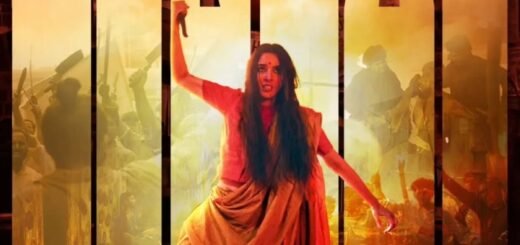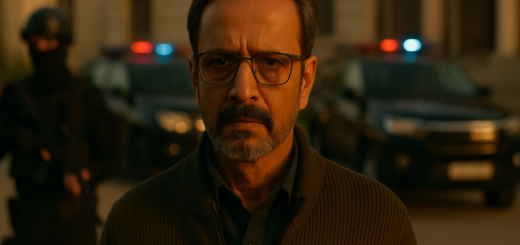Kaantha Movie Review: Dulquer Shines in Retro Drama

I walked out of Kaantha with a swirl of emotions — admiration, nostalgia, a little confusion, but mostly awe at its ambition. This isn’t just another film set in the past; it’s a love letter to cinema itself, stitched together with ego, ambition, and heartbreak. Directed by Selvamani Selvaraj and produced by Dulquer Salmaan and Rana Daggubati, Kaantha released on November 14, 2025, and immediately drew attention for its period setting, striking visuals, and powerhouse performances.
The film stars Dulquer Salmaan as T.K. Mahadevan, a rising actor in 1950s Madras; Samuthirakani as Ayya, the director who discovers and shapes him; Bhagyashri Borse as Kumari, the leading lady caught between ambition and affection; and Rana Daggubati in a key supporting role.
Story
The film takes us straight into the vibrant chaos of Madras in the 1950s — a time when cinema was young, raw, and driven by passion rather than technology. Ayya, an uncompromising director, finds potential in a young man named Mahadevan and turns him into a superstar. What begins as a mentor-protégé bond slowly mutates into rivalry and resentment.
As Mahadevan’s fame grows, his ego swells. He takes over the project they once started together, renames it Kaantha, and sidelines his mentor. Kumari, the actress caught in the middle, becomes both muse and scapegoat. And then, just when the narrative feels like a familiar story about ambition, the film takes a darker turn — a mysterious death, questions about guilt and pride, and the thin line between creation and destruction.
What really struck me was how Kaantha captures the madness of filmmaking. The sets feel alive — filled with smoke, blinding lights, cameras that clatter, and extras who rehearse endlessly. You can almost smell the sweat and anxiety that cling to every scene. The film doesn’t just tell a story; it immerses you in the heartbeat of an era when cinema itself was becoming an art form.
Performances
Dulquer Salmaan (T.K. Mahadevan) absolutely owns this film. From the first scene, he radiates charm and arrogance in equal measure. I could see the fire in his eyes — the hunger of a man who wants to be remembered forever. Dulquer slips effortlessly between the insecure newcomer and the arrogant star, and there’s a moment near the end — when he confronts Ayya — that gave me goosebumps. It’s raw and painful.
Samuthirakani (Ayya) matches Dulquer beat for beat. His calm exterior hides a storm of disappointment and pride. His portrayal of an artist who feels betrayed by his own creation hit me hard. There’s a quiet scene where he watches Mahadevan perform on set, and you can almost see the regret building behind his steady gaze.
Bhagyashri Borse (Kumari) brings freshness and poise to her role. Though the story doesn’t give her as much space as I’d hoped, she shines in the emotional scenes. Her chemistry with Dulquer feels authentic, and she never lets herself fade into the background.
Rana Daggubati arrives late in the film, and while his screen time is limited, he adds heft to the narrative. His character bridges the story’s two halves, grounding it when the pace starts to wobble.
Visuals and Technical Brilliance
The film’s biggest triumph lies in its visual storytelling. Cinematographer Dani Sanchez-Lopez paints every frame like an old photograph — warm, textured, and filled with detail. The film’s recreation of 1950s Madras is so precise that I felt transported into another world. The soft glow of the studio lights, the vintage film posters, the grainy look of the black-and-white sequences — everything feels handcrafted.
The music by Jhanu Chanthar and Jakes Bejoy perfectly complements the film’s tone. “The Rage of Kaantha,” the main track, captures the intensity of Mahadevan’s ambition, while the background score swells and fades with emotional precision.
The art direction and costume design deserve equal credit. Every prop — from the old projectors to the actors’ suits — helps build the illusion of a forgotten era.
Pacing and Writing
The first half flows beautifully. I found myself completely engrossed in the rise of Mahadevan and the growing tension with Ayya. The rhythm of those early scenes — the rehearsals, the studio gossip, the thrill of filmmaking — feels almost musical.
However, the second half drags a little. Once the story shifts into mystery mode, the pacing falters. The film loses some of its emotional momentum as it tries to tie every loose end neatly. There are moments when the dialogue turns overly dramatic, and the transitions feel abrupt.
Still, the writing shines in its insight. It doesn’t treat fame as a blessing but as a slow, consuming fire. The scenes that explore the loneliness of success — Mahadevan sitting alone after applause fades, or Ayya staring at an unfinished reel — linger long after the credits roll.
Direction and Tone
Selvamani Selvaraj directs with passion and precision. He clearly loves cinema, and that love shows in every frame. The tone is nostalgic but not sentimental. He doesn’t romanticize the golden age of cinema; he exposes its cracks. Behind the glamour lies ego, exploitation, and a hunger that eats away at everyone.
The film also feels meta in a clever way. It’s a story about making movies, told by people who understand both the beauty and the brutality of the industry. There’s an almost autobiographical honesty in how the film treats its creators — as flawed, ambitious, and human.
Strengths
- Dulquer and Samuthirakani’s performances dominate and elevate the film.
- The period recreation is breathtaking and immersive.
- The direction feels personal, grounded in emotion rather than spectacle.
- The soundtrack enhances every scene without overpowering it.
- The film’s exploration of ego and art feels mature and relatable.
Weaknesses
- The pacing in the second half dips, especially during the investigation subplot.
- Some supporting characters, including Kumari, deserved more depth.
- The climax feels slightly rushed and could have used more emotional build-up.
- The runtime (around 160 minutes) tests patience at times.
Highlights
- Best Scene: The confrontation between Ayya and Mahadevan inside a dimly lit editing room. Ayya says, “Cinema doesn’t need gods — it needs men who bleed for it.” Dulquer’s reaction is chilling.
- Best Song: “The Rage of Kaantha.” It’s fierce, cinematic, and perfectly captures the film’s energy.
- Best Moment: When the camera lingers on Mahadevan’s face as he hears his own voice echoing through a recording hall — pride and despair intertwine in one breathtaking shot.
Audience & Box Office
Kaanta doesn’t cater to every viewer. It’s not a commercial entertainer filled with fights and dance numbers. It’s an emotional, character-driven drama meant for those who love cinema — its creation, its chaos, its contradictions.
The opening weekend saw a decent turnout, especially in Tamil Nadu and Kerala. By Friday evening, early trade reports indicated collections of around ₹2.5 crore, which is solid for a niche, period-set drama. Word of mouth has been positive among cinephiles, though mixed among casual viewers.
Final Verdict
Kaantha is not a perfect film, but it’s an important one. It dares to dig into the dark, complicated relationship between art and ego. It doesn’t just tell you about cinema — it makes you feel it.
Dulquer Salmaan delivers one of his finest performances, Samuthirakani grounds the story with quiet intensity, and Selvamani Selvaraj’s direction shines with sincerity and ambition. Yes, the film stumbles in pace and structure, but its heart beats strong.
If you love stories about flawed geniuses, if you’ve ever been curious about what drives an artist to obsession, Kaantha will stay with you long after the credits fade.
My Rating: 3.5/5
⭐️⭐️⭐️½
Also Read – Delhi Crime Season 3 — My Detailed Review













